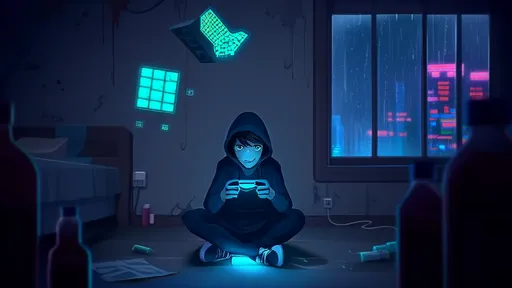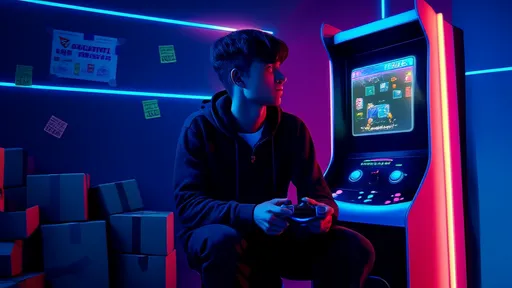In a bold move to combat drug addiction, anti-narcotics organizations are turning to an unexpected tool: video games. These aren't ordinary games, but sophisticated simulations designed to mimic the devastating effects of substance abuse. By immersing players in virtual scenarios of addiction, developers aim to provide a visceral understanding of drug dependency without the real-world consequences.
The concept might seem counterintuitive at first glance. Why would anyone create a game that simulates the very behavior we're trying to prevent? The answer lies in the power of experiential learning. Traditional anti-drug campaigns often rely on scare tactics or statistical information, methods that have proven ineffective with younger generations. These new simulations offer something different - a chance to "walk in the shoes" of an addict and witness firsthand how substance abuse can unravel lives.
One particularly striking example is "Fading Tomorrow", a game developed in collaboration with neuroscientists and former addicts. Players begin as promising college students whose lives gradually deteriorate as they make choices about drug use. The game's algorithms track every decision, altering the virtual world accordingly. Missed opportunities, broken relationships, and declining health become inevitable consequences of continued drug use.
What makes these simulations particularly effective is their psychological realism. Developers have incorporated actual neurological principles into the gameplay. As players' virtual characters become more addicted, the game mechanics change - tasks become harder to complete, cognitive functions deteriorate, and the need for the next "fix" dominates all other objectives. This mirrors the real neurochemical changes that occur in addicted brains.
The emotional impact can be profound. Many players report feeling genuine distress when their virtual families abandon them or when they fail to keep jobs due to their character's addiction. This emotional resonance is precisely what developers are aiming for - creating memories and feelings strong enough to influence real-world decisions about substance use.
Critics have raised concerns about potential risks. Could these simulations inadvertently glamorize drug use or teach players how to obtain substances? Developers address these concerns through careful design choices. The games never show drug use as pleasurable or exciting. Instead, they focus relentlessly on the consequences - the financial ruin, health deterioration, and social isolation that inevitably follow.
Early results from pilot programs in schools are promising. Students who played the simulations showed significantly improved knowledge about drug risks and stronger negative attitudes toward substance use compared to control groups. Perhaps more importantly, follow-up surveys suggest these effects persist months after the gaming experience.
The technology behind these simulations continues to evolve rapidly. Some newer versions incorporate virtual reality, creating even more immersive experiences. One VR prototype simulates the terrifying experience of overdose, complete with blurred vision, disorientation, and the panicked voices of virtual paramedics. While intense, developers argue that such experiences could literally be life-saving.
As these tools become more sophisticated, ethical questions emerge. How realistic is too realistic? Should there be age restrictions on certain simulations? How do we balance educational impact with potential psychological harm? These are questions that developers, educators, and mental health professionals continue to grapple with as the field develops.
Beyond schools, these simulations are finding applications in rehabilitation centers. Some therapists use modified versions as part of treatment programs, helping recovering addicts visualize potential relapse scenarios and their consequences. Early evidence suggests this approach may help strengthen resistance to cravings in vulnerable moments.
The global reach of these programs is expanding. International anti-drug organizations are collaborating to create culturally adapted versions for different regions. A version designed for Southeast Asia might focus on methamphetamine abuse, while an Eastern European adaptation could address opioid addiction. This localization increases relevance and effectiveness across diverse populations.
Looking ahead, developers envision even more personalized experiences. Future versions might incorporate biometric feedback, adjusting scenarios based on a player's physiological responses. Others imagine using artificial intelligence to create dynamic narratives that adapt uniquely to each user's choices and vulnerabilities.
While video games will never replace traditional prevention methods, they represent an innovative addition to the anti-drug arsenal. In a world where young people are increasingly skeptical of authority and traditional messaging, these simulations offer a powerful alternative - not telling them about the dangers of drugs, but letting them experience those dangers in a safe, controlled environment.
The ultimate goal remains prevention. If even a small percentage of players avoid substance abuse because of these virtual experiences, developers consider their work successful. As one designer put it, "We're not trying to scare kids - we're trying to show them the truth in a way they'll actually pay attention to." In an era of information overload, that truth might just be the most valuable commodity of all.

By /Jul 3, 2025

By /Jul 3, 2025

By /Jul 3, 2025

By /Jul 3, 2025

By /Jul 3, 2025

By /Jul 3, 2025

By /Jul 3, 2025

By /Jul 3, 2025

By /Jul 3, 2025

By /Jul 3, 2025

By /Jul 3, 2025

By /Jul 3, 2025

By /Jul 3, 2025

By /Jul 3, 2025

By /Jul 3, 2025

By /Jul 3, 2025

By /Jul 3, 2025

By /Jul 3, 2025